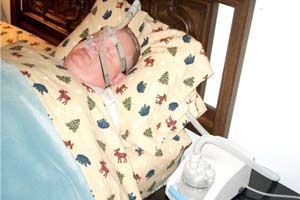Ho Chi Minh City Ear, Nose, and Throat Hospital has recently implemented a new treatment method for obstructive sleep apnea, which involves the insertion of a soft palate support pillar. The procedure takes only 5 minutes, causes minimal pain, and has fewer risks and complications compared to other surgical methods.
 |
|
A person with sleep apnea using a ventilator while sleeping. (Photo: Provided by the Ear, Nose, and Throat Hospital, VNE) |
Obstructive sleep apnea (OSA) is a condition characterized by intermittent blockages of the airway in the throat, leading to decreased blood oxygen levels and causing insomnia. These disturbances increase the risk of cardiovascular diseases such as hypertension, myocardial infarction, and cardiovascular collapse. Prolonged OSA can result in fatigue, leading to daytime drowsiness, which is a significant cause of road accidents and workplace incidents.
The soft palate support pillar insertion is a procedure that involves placing three small pieces made of polyester into the soft palate muscle structure to act as a support pillar. The purpose of inserting these three pieces is to prevent airway obstruction. This is a simple, minimally invasive, and effective surgical technique. The procedure is quick, taking only about 5 minutes, with less pain and fewer complications compared to other methods.
This method has been studied in nearly 200 patients at Mount Elizabeth Hospital in Singapore. Results showed no serious side effects or complications. The graft rejection rate was only 1.4%, and rejected grafts could be easily removed.
Experts estimate that approximately 24% of adult men and 9% of adult women are affected by obstructive sleep apnea. The severity of the condition is assessed based on the apnea-hypopnea index. This rate can rise to 37-40% among frequent snorers. Unfortunately, many patients are unaware of their condition, which is often discovered only during examinations for snoring.
The American Academy of Sleep Medicine recommends that patients with obstructive sleep apnea can use continuous positive airway pressure (CPAP) therapy for treatment. The success rate of this method is very high if patients are compliant and follow the guidelines. However, in practice, the discomfort of wearing the equipment leads to poor adherence, and doctors often resort to surgical interventions for treating obstructive sleep apnea.
There are several types of surgeries to treat obstructive sleep apnea. The most common include: uvulopalatopharyngoplasty (UPPP), which involves removing part of the soft palate, uvula, and tonsils to widen the airway, and laser-assisted uvulopalatoplasty (LAUP), which removes soft palate tissue. Both surgeries have varying success rates but come with drawbacks such as high costs, increased risks due to general anesthesia, significant postoperative pain, and potential complications like narrowing of the airway.
On the first day of implementing this technique, the Ho Chi Minh City Ear, Nose, and Throat Hospital successfully treated 5 cases of obstructive sleep apnea using the soft palate support pillar insertion method.
My Lan

















































